( IIi Mint and Tihwa Mint )
|
China was known as "Serice" [means a country of silk] by the peoples of ancient Greece and Roma. Sinkiang is just located on the trunk of the Silk Road which connected the Central China and the western world before the sea route was germinated in the modern times. Since the establishment of the 西域都戶府 "Hsi-Yu Tu-HU-Fu" [General Governor's Office of the Western Region] in 烏壘 [now northeastern of Luntai] in the 2nd year of the Shen-Chueh period (60BC) of Emperor Hsuan Ti reign of the Western Han Dynasty, Sinkiang has been under the control sporadically of the Chinese governments of each dynasty for more than 2000 years. Silk Road served as an important route of economic and cultural exchanges between the East and the West in the past. Before the issue of official currencies by the governments of ancient China, various kinds of coin were flowed into Sinkiang from Central-Asian, West-Asian as well as Central China and were circulated in different regions. During early Qing dynasty, Dzungaria Tribes-made "Pul" copper coin were widely circulated in Sinkiang until the rebellion of the Dzungaria Tribes was put down by the Qing government in 1757. Sinkiang had its own coinage was postponed until 1760, when the establishment of the (Yarkand) Yerkiyang Mint [now Sache] by the decree of Emperor Ch'ienlung of the Qing Dynasty. From that time, all the Dzungaria Tribes-made "Pul" coppers current in South Sinkiang be melted and recast into "Ch'ien Lung T'ung Pao" red cash in the same shape as the Qing standard cash. Red Cash was a special currency, because it was made of pure copper with Urgur and Han inscriptions on the reverse. During the later period of Qing Dynasty, some of the red cash were inscribed with Manchu scripts on the reverse too. Actually, Sinkiang Standard Cash of IIi Mint and Tihwa Mint were made of copper, present Chinese collectors accustomed to call them "Red Cash" too. Pul coin was minted in Central Asia. "Pul" means copper money and "Tanga" means silver money. "Pul" was cast with copper, each piece weighting 0.2 tael and 50 pieces made a Tanga. As red cash was also made of copper, Chinese accustomed to call them "Pul" too. [A History of Chinese Currency (16th Century BC - 20th Century AD), 1983 Jointly Published by Xinhua (New China), p.212] Sinkiang is deivided by the Tianshan Mountains into two parts in the geographical features. In Chinese numismatics, the north of Tianshan Mountains is belonged to Standard Cash Circulation Zone, while the south of Tianshan Mountains is Red Cash Circulation Zone. During the early period of the Qing Dynasty, red cash were permitted to circulate in the south of Sinkiang only, until the 16th year of the Emperor Kuangshu region (1890), red cash was circulated in the north of Sinkiang too. The exchange rate of red cash for standard cash was 1 to 5 at the early beginning. After 1760, when red cash started to circulate in the south of Sinkiang, standard cash from the other parts of China still circulating in the north of Sinkiang.]. |
Marks of Rareness of the Collected Currencies
Extremely Rare A ~ Very Rare B ~ Rare C ~ Not So Many E ~ Common E
| Obverse | Reverse | Description |
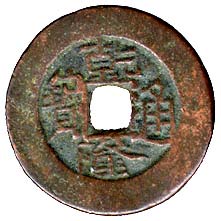 | 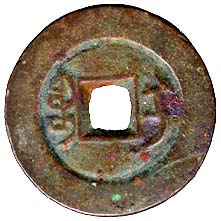 | No. 142 |
| Diam. 25 mm | ||
| Wt. 5.4 g. | ||
| Rareness D | ||
| Mint Evolution and Peculiarity | ||
|
IIi Mint was established in 1775, the last mint founded in Sinkiang during Ch'ien Lung period, for the casting of the Sinkiang standard cash coins which show the mint mark "Pao-I" on the reverse in Manchu script only. On the obverse of this cash is the legend of "Ch'ien Lung T'ung Pao" in direct reading or symmetric reading. The obverse of the Sinkiang cash was known as very blurred, lacking that clear cut outline of the characters. But for this coin is not quite suitable. I think it is because this cash was cast in the Ch'ien Lung period with its exquisite carving technique and excellent minting quality apart from those made in the later reign. IIi's coins went parallel with standard coins cast by the other parts of the country. [More about Ch'ien Lung T'ung Pao] | ||
| Obverse | Reverse | Description |
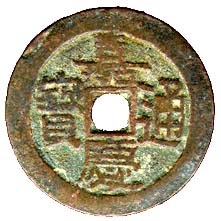 |
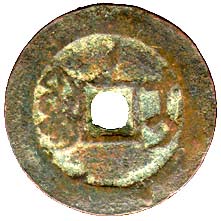 | No. 140 |
| Diam. 25 mm | ||
| Rareness C | ||
| Wt. 5.0 g. | ||
| Mint Evolution and Peculiarity | ||
|
This copper cash with a square in the centre, four Chinese characters (Chia Ch'ing Current Coin) on the obverse and two Manchu characters meaning (Pao-I Mint) on either side of the hole on the reverse. First minted in 1796. There was a variety of this coin cast, the major ones being the different Mint marks appeared on the reverse. For this coin a vertical line above the hole on the reverse. Please be noted that there were only two Mints remainded in operation in Sinkiang district during Chia Ch'ing period (1796-1820). They are Aksu and IIi Mints, as Yerkiyang or Yarkand Mint ceased in 1769. The inscriptions of the Chia Ch'ing Sinkiang cash are very simple, as it would not denote the denomination, the date or more than 2 types of scritps appeared on the same cash. Moreover, I would like to point out that Chia Ch'ing Pao-I cash is quite rare. [As I know that the Pao-I cash is known for scarcity by Chinese collectors in China. If this is true or you find difficult to get one. I suggest you try to contact the Russian collectors, they may be easy to get.] | ||
| Obverse | Reverse | Description |
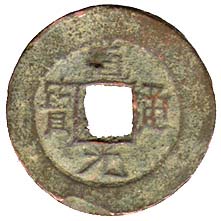 |
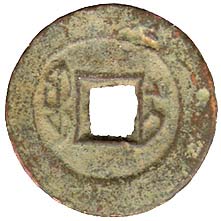 | No. 143 |
| Diam. 23.5 mm | ||
| Wt. 3.7 g. | ||
| Rareness D | ||
| Mint Evolution and Peculiarity | ||
| The coinage of Sinkiang in Tao Kuang period (1821-1850) is similar as the Chia Ch'ing period (1796-1820), there were only two Mints remainded in operation. They are Aksu and IIi Mints. As the Tao Kuang Sinkiang cash was composed of both the cash made in the reign of Tao Kuang and those made in the Kuang Hsu reign, we may find some of the Tao Kuang Sinkiang cash inscribed with Kuche Mint on the reverse. Yes, they are those cast by Kuche Mint in 1885 or 1886. This copper cash was first cast in the 1st year of the Tao Kuang reign of Emperor Hsuan Tsung of the Qing Dynasty (1821AD). Four Chinese characters (Tao Kuang Current Coin) on the obverse, and two Manchu scripts meaning (Pao-I Mint) on the reverse. The outer rims on the both sides are quite wide and the strokes of the characters are thin and straight. Some of the Tao-Kuang Pao-I coins appeared with special mint marks on the reverse, they were inscribed with a rectangular head T'ung  on the obverse, while the other were inscribed with a trangular head T'ung on the obverse, while the other were inscribed with a trangular head T'ung  . .
| ||
| Obverse | Reverse | Description |
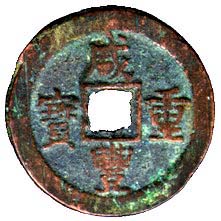 |
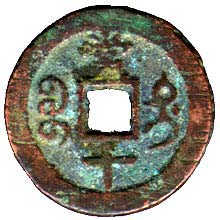 | No. 144 |
| Diam. 27 mm | ||
| Wt. 5.7 g. | ||
| Rareness D | ||
| Mint Evolution and Peculiarity | ||
|
Another mint which cast standard cash coins in the north of Sinkiang, is Tihwa Mint. Tihwa city was originally known as Urumchi [means fine pasture]. It was renamed as Tihwa, with the meaning of 啟迪教化 "Ti-Chi Chiao-Hua" [means to instruct and educate. I really don't like the meaning. Because, the Qing government believed the Chinese Empire was the only civilized place in the world, people who lived outside the Central China were "barbarians". They needed to be educated.] in the 20th year of the Ch'ien Lung period. Tihwa Mint was established in the 5th year of the Hsien Feng reign (1855AD), and it terminated casting coins in 1861. There are four Chinese characters (Hsien Feng Chung Pao) on the obverse and two Manchu characters meaning (Tihwa Mint) on either side of the hole on the reverse, and there are also two Chinese characters as denomination "Tang Shih"  [means equivalent to ten cash] above and below of the hole.
Tihwa Mint reopened to produce red cash coins in the 20th year of Emperor Kuanghsu reign (1886AD), but its name had been changed to Pao-Hsin Mint. [Hsin means new] [means equivalent to ten cash] above and below of the hole.
Tihwa Mint reopened to produce red cash coins in the 20th year of Emperor Kuanghsu reign (1886AD), but its name had been changed to Pao-Hsin Mint. [Hsin means new]
| ||